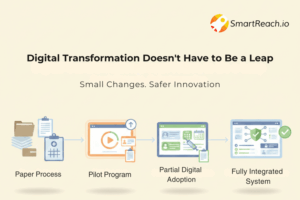How to Stay Compliant with Healthcare Marketing Regulations?
In healthcare marketing, creativity alone doesn’t cut it.
Every ad, landing page, or social post lives under the microscope of compliance, and one careless claim can cost millions or permanently damage brand trust.
As healthcare brands go digital across Google, Meta, and programmatic channels, regulatory scrutiny is at an all-time high.
Marketers are now expected to deliver performance and precision, ensuring every message is compliant with FDA, HIPAA, and FTC standards.
So how do you build campaigns that drive conversions without crossing legal lines?
Let’s break it down.
Why Compliance Matters in Healthcare Marketing
Healthcare marketing is unlike any other industry; the stakes are higher because the subject is people’s health.
One misleading message can influence treatment decisions, spread misinformation, or violate patient privacy.
The Risks of Non-Compliance
Legal penalties: FDA and FTC fines can reach into the millions.
Reputation loss: One public FDA letter can undo years of brand-building.
Erosion of trust: Patients and physicians won’t forgive misleading communication.
The Regulatory Reality
The healthcare ad landscape is governed by multiple authorities, FDA, HIPAA, FTC, GDPR, all working to protect consumers from false claims and privacy breaches.
Marketers who understand these frameworks early gain a competitive advantage, whether you’re promoting direct-to-consumer products or B2B healthcare solutions.
Key Regulatory Bodies and What They Oversee
a. FDA (Food and Drug Administration)
The FDA regulates how drugs, devices, and treatments are promoted, including ads, videos, and even social media posts.
Your claims must be truthful, not misleading, and balanced between risks and benefits.
Misleading Example: “Clinically proven to cure arthritis in 7 days!”
Compliant Alternative: “In clinical studies, patients experienced improvement in joint mobility within one week.”
b. FTC (Federal Trade Commission)
The FTC focuses on truthful advertising and consumer protection.
If you use influencers, testimonials, or endorsements, disclosures must be clear and visible, no fine print surprises.
c. HIPAA (Health Insurance Portability and Accountability Act)
HIPAA protects patient health information (PHI).
That means no retargeting, tracking, or campaign segmentation that reveals or uses identifiable health data without consent.
Example: You can’t use Meta Pixel to retarget users who visited a “Depression Treatment” page unless the setup fully anonymizes and encrypts user data.
d. Other Regional Regulations
GDPR (Europe): Strict consent requirements for data tracking.
CCPA (California): Gives users control over personal data usage.
DPDPA (India): Governs digital personal data handling and storage.
If your campaigns cross borders, your compliance must too.
Common Compliance Challenges in Healthcare Marketing
Even experienced teams stumble here:
- Using patient stories without written consent.
- Sharing PHI through third-party pixels or analytics tools.
- Overstating product efficacy (“proven cure,” “guaranteed results”).
- Targeting ads based on sensitive health conditions.
- Using email automation tools that don’t respect healthcare data boundaries.
The root cause?
A disconnect between marketing speed and regulatory awareness.
That’s why integrating compliance early into your workflow saves both time and damage control.
FDA and Industry Standards for Digital Campaigns
a. Ad Content Compliance
The FDA requires that all healthcare promotional content be:
- Truthful and evidence-based.
- Balanced between benefits and risks.
- Clearly labeled if it’s sponsored or promotional.
Every claim should trace back to credible scientific evidence, ideally peer-reviewed or FDA-approved sources.
b. Social Media Advertising Rules
Yes, even tweets can get flagged.
The FDA treats social posts as promotional materials, which means hashtags and stories fall under the same scrutiny.
The popular “one-click rule” (linking to risk info) is risky, if the key risks aren’t visible within the post itself, it’s still considered noncompliant.
c. Website & Landing Page Compliance
Your website is your biggest compliance minefield.
Make sure to:
- Add disclaimers and consent banners for all data collection.
- Ensure contact forms and cookies follow HIPAA/GDPR requirements.
- Avoid using unencrypted third-party tracking pixels.
Pro tip: Use first-party data tracking to stay compliant without losing insights.
d. Email Marketing Compliance
Whether you’re reaching patients directly or conducting B2B outreach to healthcare professionals (HCPs), clinics, or hospitals, email campaigns must comply with CAN-SPAM Act, HIPAA, and GDPR.
For B2C Patient Campaigns:
- Never use health conditions or treatment history for targeting.
- Include clear opt-out mechanisms in every email.
- Obtain explicit consent before adding contacts to healthcare-related lists.
For B2B Healthcare Outreach: If you’re marketing medical devices, health tech solutions, or pharmaceutical services to decision-makers, compliance shifts but remains critical.
B2B outreach tools like SmartReach.io help healthcare tech companies maintain compliant cold email automation by:
- Managing opt-outs automatically (CAN-SPAM compliance).
- Personalizing outreach based on professional roles, not patient data.
- Integrating with CRM systems to track engagement without storing PHI.
Key Rule: Even in B2B healthcare marketing, never use patient health information for targeting. Segment by job title, company size, or industry, never by diagnosis or treatment.
Data Collection & Targeting: Staying HIPAA-Compliant
Here’s the simple rule: If data can identify a patient, protect it like gold.
What You Can Track
- Anonymous engagement metrics (pageviews, bounce rate).
- Form submissions with explicit consent.
- Aggregated data from compliant analytics platforms.
- Professional engagement data in B2B campaigns (e.g., HCP email opens, webinar attendance), as long as no PHI is involved.
What You Can’t Track
- Sensitive health activity tied to an identifiable user.
- Retargeting based on diagnosis, symptoms, or treatments.
- Using patient lists or health records to build audiences, even if anonymized improperly.
How to Stay Safe
- Use HIPAA-compliant tools that anonymize and encrypt user data.
- Switch from third-party to first-party data tracking for remarketing.
- Store consent logs for every campaign touchpoint.
- For B2B outreach, use professional contact data from verified sources, never patient databases.
Example Setup: User visits your site → Consent captured → Data tracked via first-party cookie → Audience built for compliant remarketing.
B2B Example: Hospital administrator downloads a white paper → Consent captured → Follow-up email sequence triggered via compliant automation tool → No health data used, only professional engagement tracked.
Best Practices for Creating Compliant Healthcare Campaigns
1. Create a Compliance Checklist
Before every campaign launch, run through a simple checklist covering FDA, HIPAA, and FTC guidelines.
This ensures your messaging, visuals, and targeting meet the required standards.
A quick pre-launch review can save you from costly fixes and public warnings later.
2. Involve Compliance Teams Early
Don’t treat compliance as a last-minute hurdle, bring legal and regulatory reviewers in from the start.
Early collaboration reduces back-and-forth revisions and speeds up approvals.
Think of them as your partners in building trustworthy, risk-free campaigns.
3. Train Marketing Teams
Everyone touching the campaign, from writers to designers, should know the basics of compliance.
Regular training helps them spot red flags before content even reaches review.
When compliance awareness becomes part of your culture, fewer mistakes make it out the door.
4. Use Consent-Based Marketing
Collect data only with clear, explicit consent from users at every touchpoint.
Rely on first-party data and privacy-safe tracking to personalize without crossing lines.
This builds transparency, improves targeting accuracy, and strengthens user trust.
Pro Tip for Multi-Channel Campaigns: If you’re running coordinated email, social, and retargeting campaigns, ensure consent is captured consistently across all channels. For B2B healthcare campaigns, platforms like SmartReach integrate with CRM systems to maintain consent records while automating follow-ups, keeping your outreach both efficient and compliant.
5. Document Everything
Keep detailed audit trails for every version, approval, and compliance review.
In case of regulatory audits, you’ll have a clear record of responsible marketing practices.
Documentation isn’t just admin, it’s your insurance policy for credibility and peace of mind.
6. Segment B2C and B2B Strategies Clearly
Healthcare marketing isn’t one-size-fits-all.
B2C campaigns (targeting patients) require stricter PHI protections and FDA oversight.
B2B campaigns (targeting healthcare providers, hospital buyers, or medtech decision-makers) operate under different rules, focusing on professional data, not patient information.
Keeping these strategies separate in your workflow prevents cross-contamination of data and ensures each channel follows the right compliance framework.
Writing Messaging That Sells and Stays Compliant
Here’s where most marketers trip up.
You finally get that perfect headline, catchy, emotional, persuasive, and then your compliance team says, “We can’t say that.”
Sound familiar?
The truth is, you don’t have to choose between creativity and compliance. You just have to learn how to write smart.
Because the best campaigns don’t sound restricted, they sound trustworthy.
Here’s the Difference
Let’s look at two examples:
“100% safe and side-effect free.” – Wrong
“In clinical studies, 70% of participants reported reduced pain symptoms.” – Right
See the difference?
The first one sounds too good to be true, and regulators will agree.
The second one? It’s factual, credible, and still persuasive.
That’s the sweet spot: confidence backed by evidence.
Simple Language Swaps That Keep You Out of Trouble
Small word changes can make a big difference. Try these:
- Instead of “cures,” say “helps manage.”
- Instead of “guarantees,” say “may improve.”
- Instead of “clinically proven,” say “supported by clinical evidence.”
These phrases sound more grounded, and they tell your audience that you’re being honest with them.
That kind of authenticity builds trust, and trust converts faster than hype ever will.
Copywriter’s Cheat Sheet: Dos and Don’ts
Do:
- Use evidence-backed statements.
- Include disclaimers clearly, not hidden in tiny text.
- Use testimonials carefully (and never to replace proof).
- Focus on clarity and education over hype.
Don’t:
- Promise guaranteed results.
- Ignore side effects or limitations.
- Cherry-pick data to make claims look stronger.
- Skip medical review just because “it’s a small post.”
Every piece of content, from a tweet to a landing page, represents your brand’s integrity.
And in healthcare, integrity sells.
How Technology Can Simplify Compliance
Regulations change, campaigns move fast, and human error creeps in easily.
That’s where technology steps in, not to replace responsibility, but to make it scalable and consistent.
Compliance software is your silent hero, it keeps processes structured and transparent.
It automates workflow approvals, manages version control, and maintains audit logs for every campaign.
Instead of juggling email threads or spreadsheets, you have a clear trail from draft to launch.
The result? Fewer compliance errors, faster reviews, and stronger accountability across teams.
Top Platforms That Make Compliance Easier
1. Veeva Vault PromoMats
A trusted platform for regulated industries like pharma and medtech.
It manages everything, from promotional content creation to legal and medical reviews, in one place.
Built-in audit trails ensure every approval is tracked and time-stamped. Teams using Veeva cut approval times dramatically while keeping regulators happy.
2. CustomerLabs 1PD Ops
Perfect for healthcare marketers who rely on first-party data tracking. It helps you collect, hash, and activate user data safely without violating HIPAA or GDPR.
You can control exactly what gets shared with ad platforms, keeping PHI protected. Brands using CustomerLabs 1PD Ops see both higher ROAS and cleaner compliance records.
3. SmartReach (For B2B Healthcare Outreach)
If your healthcare brand sells to businesses, medical device companies, health tech startups, hospital networks, or pharmaceutical distributors, you need compliant B2B outreach automation.
SmartReach enables healthcare tech marketers to:
- Automate cold email sequences to HCPs, hospital buyers, or clinic administrators.
- Manage multi-channel outreach (email + LinkedIn) while maintaining CAN-SPAM compliance.
- Integrate with CRM systems to track professional engagement, without storing patient health information.
Use Case Example: A medical software company used SmartReach to reach hospital IT directors with personalized email sequences. By targeting professional pain points (not patient data), they achieved 40% open rates and 15% demo booking rates, all while staying fully compliant with CAN-SPAM and HIPAA guidelines.
Compliance Note: B2B healthcare outreach tools like SmartReach are designed for professional targeting only. Never use patient data, health records, or treatment history for segmentation, even in B2B campaigns.
How These Tools Reduce Risk and Speed Up Approvals
Using compliance tech means less guesswork and fewer bottlenecks.
Every campaign follows a predefined review workflow, so no one skips a step.
Automated audit trails protect your brand during inspections or regulatory inquiries.
Ultimately, these tools help you launch faster, reduce risk, and stay confidently compliant, whether you’re running B2C patient campaigns or B2B healthcare sales outreach.
Case Example: Doing Compliance Right
A digital wellness brand running Meta Ads faced constant disapproval due to privacy issues.
They switched to a first-party data model using tools like CustomerLabs 1PD Ops, which allowed them to:
- Collect, hash, and activate user data safely without violating HIPAA.
- Build custom audiences using compliant data.
- Achieve 3x higher ROAS without triggering HIPAA red flags.
The takeaway? Compliance didn’t slow them down; it made them unstoppable.
To Conclude
Compliance isn’t the enemy of creativity, it’s what gives your marketing integrity.
When every message is accurate, transparent, and ethical, your brand builds something far more valuable than clicks: trust.
And in healthcare, trust isn’t just nice to have, it’s everything.
Whether you’re launching patient-focused campaigns or B2B outreach to healthcare professionals, the principles remain the same: transparency, accuracy, and respect for privacy.
So before your next campaign goes live, ask: “Is this message compliant, credible, and clear?”
If yes, you’re not just safe. You’re ready to scale.
FAQs
What is healthcare marketing compliance?
Healthcare marketing compliance means adhering to FDA, HIPAA, and FTC regulations when promoting health products or services. It ensures truthful claims, protects patient data, and balances benefits with risks. Non-compliance results in million-dollar fines and reputation damage.
What are the main regulations for healthcare advertising?
The three primary regulations are FDA guidelines (drug/device promotion), HIPAA (patient data protection), and FTC rules (truthful advertising). FDA requires evidence-backed claims, HIPAA prohibits using patient data without consent, and FTC mandates clear disclosures for testimonials.
Can I use patient testimonials in healthcare marketing?
Yes, with explicit written consent and legal disclaimers. Testimonials must not guarantee results or make unsubstantiated claims. FDA requires they represent typical outcomes, not exceptional cases. Include disclaimers like “Results may vary” to maintain compliance.
What is HIPAA compliance in digital marketing?
HIPAA compliance means protecting patient health information (PHI) in campaigns. You cannot retarget based on health conditions or share patient data with third-party platforms without consent. Use encrypted, anonymized tracking and obtain explicit consent before collecting health data.
How do I write compliant healthcare ad copy?
Use evidence-backed language and avoid absolute claims like “cure” or “guaranteed.” Say “may help manage” instead of “cures.” Balance benefits with risks, cite credible sources, and include required disclaimers. Every claim needs legal or medical review approval.
What tools help maintain healthcare marketing compliance?
Veeva Vault PromoMats streamlines approvals with audit trails. CustomerLabs 1PD Ops collects, hashes, and activates data safely without violating HIPAA. SmartReach automates CAN-SPAM-compliant B2B email sequences to medical professionals without using patient data.



